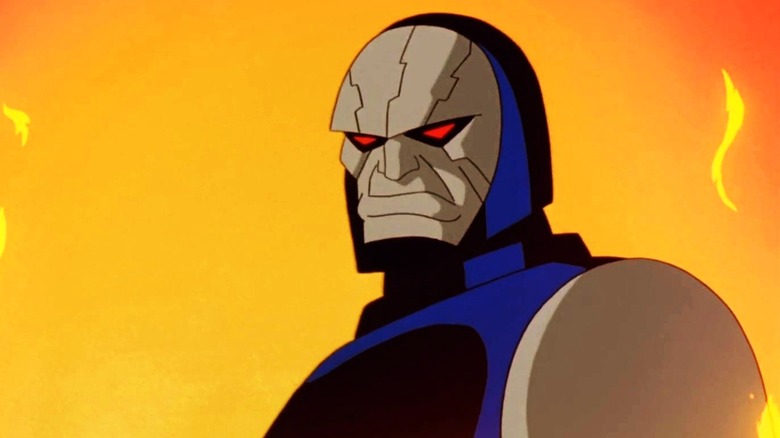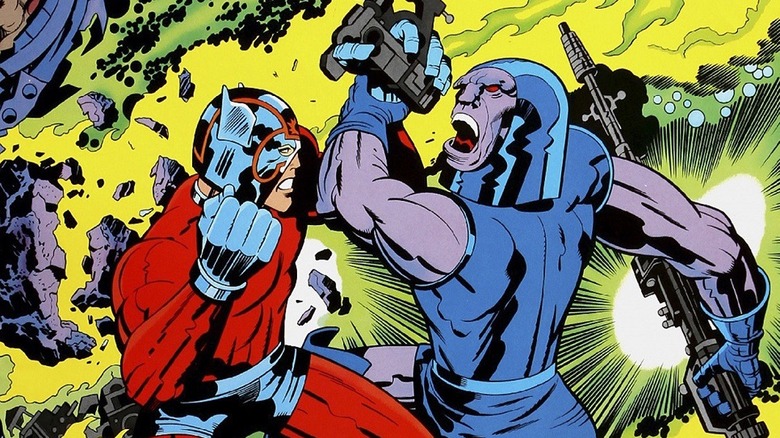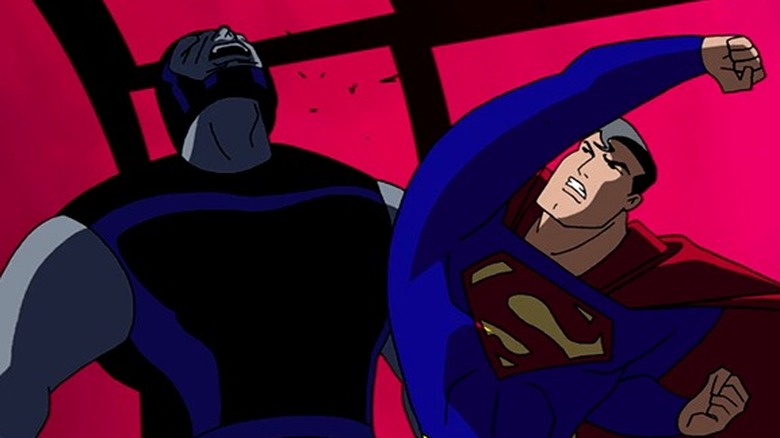Superman: The Animated Series Had A Problem That Introducing Darkseid Was Meant To Solve
A hero is only as good as his villains, which helps explain why Batman has eclipsed Superman as DC Comics' trademark character. There are at least two dozen memorable villains in the Gotham City rogues gallery, while Metropolis has less than half that. Bruce Timm, an architect of both "Batman: The Animated Series" and "Superman: The Animated Series," is aware of this.
In a 2021 interview with Comic Book Resources, Timm said that, "Superman's rogues gallery was not as visually interesting as Batman's rogues gallery." At first glance, that's a blunt statement, but it's also quite revealing. For one, Timm's vocation as an artist means he prioritizes character design. Secondly, he's right — even the best Superman villains aren't as colorful as the best Batman ones. Lex Luthor is just a normal man in a business suit, and it's essential to his conflict with Superman that he be nothing more. Bizzaro's design is just an inversion of Superman's, Metallo is basically a Terminator, and Brainiac ... well, his classic design needed an update.
This is why when making "Superman," Timm and co. looked outside Metropolis and to Jack Kirby's "Fourth World." This meant not only bringing in Darkseid, a villain who could challenge or possibly beat the Man of Steel, but also a whole cadre of supporting villains with striking designs.
Background on the Fourth World
The Fourth World is the collective name for three comic series written and drawn by Jack Kirby during the early 1970s: "New Gods," "The Forever People," and "Mister Miracle." The series told the stories of the New Gods, who came into being after the "Old Gods" perished in an apocalyptic war. These New Gods lived on New Genesis, ruled by the benevolent Highfather, and Apokolips, ruled by Darkseid. In the comics, more and more of the New Gods venture to Earth because Darkseid believes the planet holds his vaunted Anti-Life Equation, which can eradicate free will.
As recounted in "Tales to Astonish: Jack Kirby, Stan Lee, and the American Comic Book Revolution" by Ronin Ro, Kirby originally conceived of the series while at Marvel Comics. In fact, it was meant to be a follow-up to his work on "Thor." Kirby's plan was that Thor and co. would die in Ragnarök, like in the Norse myths of old, and the New Gods would rise from the ashes. Marvel editorial, however, wouldn't kill off one of their golden geese. So, when Kirby jumped ship to DC, he took the Fourth World with him.
The story wasn't an instant success. "New Gods" and "The Forever People" ended prematurely after issue #11. "Mister Miracle" held on for 18 issues, with its finale capping off the series but promising Darkseid's threat wasn't over.
"New Gods" was reprinted in 1984 followed by a delayed conclusion, "Hunger Dogs." Instead of the Fourth World concluding, it became a cornerstone of the DC Universe. Darkseid is also DC's unifying big bad, now more a villain for the Justice League than his sons Orion and Mister Miracle. The DC Animated Universe helped shape this development, and it all started with "Superman: The Animated Series."
Darkseid is...
On top of the three main "Fourth World" series, Jack Kirby also wrote "Superman's Pal Jimmy Olsen" for a time, and used it as an ancillary part of his saga. Indeed, Darkseid debuted in "Superman's Pal Jimmy Olsen #134." According to Bruce Timm, this is what gave him and his team the in to use the Fourth World in "Superman."
Darkseid and Apokolips had been animated in "The Super Powers Team: Galactic Guardians," the final season of "Super Friends." However, Timm's Darkseid was a more formidable adversary, closer to Sauron than Skeletor. Darkseid's design, faithful to the comics, was brilliant in its simplicity. He wore a simple black tunic and was only about six feet tall, but his stone face betrayed his inhumanity. His Omega Beams contrasted nicely with Superman's heat vision. Additionally, Michael Ironside voiced the villain, and his bone-chilling authority was a perfect touch.
The show's creative team also understood that Darkseid was not a simple "dark lord," but an allegory for fascist rule and how it dilutes individuality. In "Legacy," Superman throws a defeated Darkseid to the oppressed masses of Apokolips, expecting they'll retaliate against their oppressor. Instead, they help the tyrant to his feet. Darkseid boasts, "I am many things, Kal-El, but here ... I am God."
Apokolips is also home to colorful supporting villains, from Darkseid's neglected son Kalibak (voiced by Worf himself Michael Dorn), to the vicious and varied Female Furies. Timm himself expressed a soft spot for Granny Goodness, Apokolips' androgynous torturer (voiced by Ed Asner). The Fourth World, Darkseid especially, would continue to appear in the DC Animated Universe to its end, all the way to the finale of "Justice League Unlimited." After all, you can only have so many Lex Luthor episodes.


